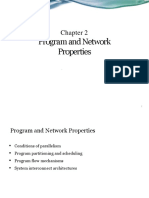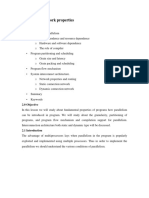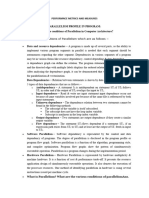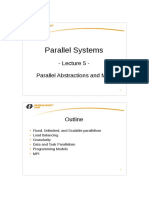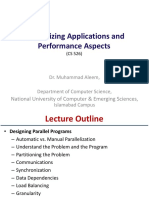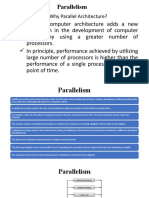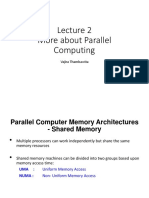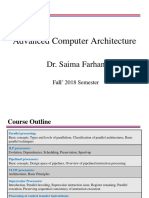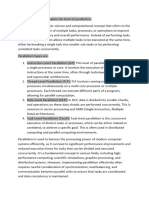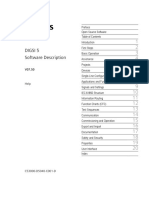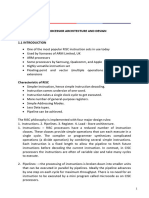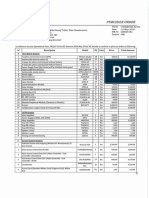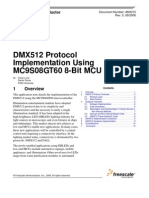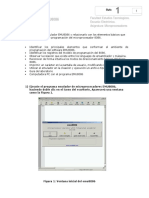Chapter 2: Program and Network Properties
Conditions of parallelism
Program partitioning and scheduling
Program flow mechanisms
System interconnect architectures
EENG-630 - Chapter 2
�Conditions of Parallelism
The exploitation of parallelism in computing requires
understanding the basic theory associated with it.
Progress is needed in several areas:
computation models for parallel computing
interprocessor communication in parallel architectures
integration of parallel systems into general environments
EENG-630 - Chapter 2
�Data dependences
The ordering relationship between statements is indicated by the data
dependence.
Flow dependence
Anti dependence
Output dependence
I/O dependence
Unknown dependence
EENG-630 - Chapter 2
�Data Dependence - 1
Flow dependence: S1 precedes S2, and at least one output of S1 is
input to S2.
Antidependence: S1 precedes S2, and the output of S2 overlaps the
input to S1.
Output dependence: S1 and S2 write to the same output variable.
I/O dependence: two I/O statements (read/write) reference the
same variable, and/or the same file.
�Data Dependence - 2
Unknown dependence:
o
The subscript of a variable is itself subscripted.
The subscript does not contain the loop index variable.
A variable appears more than once with subscripts having different
coefficients of the loop variable (that is, different functions of the loop
variable).
The subscript is nonlinear in the loop index variable.
Parallel execution of program segments which do not have total data
independence can produce non-deterministic results.
�Data dependence example
S1:
S2:
S3:
S4:
Load R1, A
Add R2, R1
Move R1, R3
Store B, R1
S1
S2
S4
S3
EENG-630 - Chapter 2
�I/O dependence example
S1:
S2:
S3:
S4:
Read (4), A(I)
Rewind (4)
Write (4), B(I)
Rewind (4)
S1
EENG-630 - Chapter 2
I/O
S3
�Control dependence
The order of execution of statements cannot be determined before
run time
o
Conditional branches
Successive operations of a looping procedure
EENG-630 - Chapter 2
�Control dependence examples
Do 20 I = 1, N
A(I) = C(I)
IF(A(I) .LT. 0) A(I)=1
20 Continue
Do 10 I = 1, N
IF(A(I-1) .EQ. 0) A(I)=0
10 Continue
EENG-630 - Chapter 2
�Resource dependence
Concerned with the conflicts in using shared resources
o
Integer units
Floating-point units
Registers
Memory areas
ALU
Workplace storage
EENG-630 - Chapter 2
�Bernsteins conditions
Set of conditions for two processes to execute in parallel
I1 O2 =
I2 O1 =
O1 O 2 =
EENG-630 - Chapter 2
�Bernsteins Conditions - 2
In terms of data dependencies, Bernsteins conditions imply that
two processes can execute in parallel if they are flow-independent,
antiindependent, and output-independent.
The parallelism relation || is commutative (Pi || Pj implies Pj || Pi ),
but not transitive (Pi || Pj and Pj || Pk does not imply Pi || Pk ) .
Therefore, || is not an equivalence relation.
Intersection of the input sets is allowed.
�Utilizing Bernsteins conditions
P1 :
C=DxE
P2 :
M=G+C
P3 :
A=B+C
P4 :
C=L+M
P5 :
F=G/E
P1
P2
P4
P3
P5
EENG-630 - Chapter 2
�Utilizing Bernsteins conditions
�Hardware parallelism
A function of cost and performance tradeoffs
Displays the resource utilization patterns of
simultaneously executable operations
Denote the number of instruction issues per
machine cycle: k-issue processor
A multiprocessor system with n k-issue processors
should be able to handle a maximum number of nk
threads of instructions simultaneously
EENG-630 - Chapter 2
�Software parallelism
Defined by the control and data dependence of programs
A function of algorithm, programming style, and compiler
organization
The program flow graph displays the patterns of simultaneously
executable operations
EENG-630 - Chapter 2
�Mismatch between software and hardware parallelism - 1
Cycle 1
L1
L2
L3
L4
Cycle 2
X1
X2
Cycle 3
Maximum software
parallelism (L=load,
X/+/- = arithmetic).
�Mismatch between software and hardware
parallelism - 2
Same problem, but
considering the
parallelism on a two-issue
superscalar processor.
X1
L1
Cycle 1
L2
Cycle 2
L3
Cycle 3
L4
Cycle 4
X2
Cycle 5
Cycle 6
Cycle 7
�Mismatch between software and hardware
parallelism - 3
Same problem,
with two singleissue processors
= inserted for
synchronization
L1
L3
Cycle 1
L2
L4
Cycle 2
X1
X2
Cycle 3
S1
S2
Cycle 4
L5
L6
Cycle 5
Cycle 6
�Software parallelism
Control parallelism allows two or more operations to be
performed concurrently
o
Pipelining, multiple functional units
Data parallelism almost the same operation is performed over
many data elements by many processors concurrently
o
Code is easier to write and debug
EENG-630 - Chapter 2
�Types of Software Parallelism
Control Parallelism two or more operations can be performed
simultaneously. This can be detected by a compiler, or a
programmer can explicitly indicate control parallelism by using
special language constructs or dividing a program into multiple
processes.
Data parallelism multiple data elements have the same operations
applied to them at the same time. This offers the highest potential
for concurrency (in SIMD and MIMD modes). Synchronization in
SIMD machines handled by hardware.
�Solving the Mismatch Problems
Develop compilation support
Redesign hardware for more efficient exploitation by compilers
Use large register files and sustained instruction pipelining.
Have the compiler fill the branch and load delay slots in code
generated for RISC processors.
�The Role of Compilers
Compilers used to exploit hardware features to improve
performance.
Interaction between compiler and architecture design is a necessity
in modern computer development.
It is not necessarily the case that more software parallelism will
improve performance in conventional scalar processors.
The hardware and compiler should be designed at the same time.
�Program Partitioning & Scheduling
The size of the parts or pieces of a program that can be considered
for parallel execution can vary.
The sizes are roughly classified using the term granule size, or
simply granularity.
The simplest measure, for example, is the number of instructions in
a program part.
Grain sizes are usually described as fine, medium or coarse,
depending on the level of parallelism involved.
�Latency
Latency is the time required for communication between different
subsystems in a computer.
Memory latency, for example, is the time required by a processor to
access memory.
Synchronization latency is the time required for two processes to
synchronize their execution.
Computational granularity and communicatoin latency are closely
related.
�Levels of Parallelism
Jobs or programs
Increasing
communication
demand and
scheduling
overhead
Higher degree
of parallelism
Subprograms, job steps or
related parts of a program
Procedures, subroutines,
tasks, or coroutines
Non-recursive loops
or unfolded iterations
Instructions
or statements
}
}
}
Coarse grain
Medium grain
Fine grain
�Instruction Level Parallelism
This fine-grained, or smallest granularity level typically involves less
than 20 instructions per grain. The number of candidates for
parallel execution varies from 2 to thousands, with about five
instructions or statements (on the average) being the average level
of parallelism.
Advantages:
o
There are usually many candidates for parallel execution
Compilers can usually do a reasonable job of finding this parallelism
�Loop-level Parallelism
Typical loop has less than 500 instructions.
If a loop operation is independent between iterations, it can be
handled by a pipeline, or by a SIMD machine.
Most optimized program construct to execute on a parallel or vector
machine
Some loops (e.g. recursive) are difficult to handle.
Loop-level parallelism is still considered fine grain computation.
�Procedure-level Parallelism
Medium-sized grain; usually less than 2000 instructions.
Detection of parallelism is more difficult than with smaller grains;
interprocedural dependence analysis is difficult and historysensitive.
Communication requirement less than instruction-level
SPMD (single procedure multiple data) is a special case
Multitasking belongs to this level.
�Subprogram-level Parallelism
Job step level; grain typically has thousands of instructions;
medium- or coarse-grain level.
Job steps can overlap across different jobs.
Multiprograming conducted at this level
No compilers available to exploit medium- or coarse-grain
parallelism at present.
�Job or Program-Level Parallelism
Corresponds to execution of essentially independent jobs or
programs on a parallel computer.
This is practical for a machine with a small number of powerful
processors, but impractical for a machine with a large number of
simple processors (since each processor would take too long to
process a single job).
�Communication Latency
Balancing granularity and latency can yield better performance.
Various latencies attributed to machine architecture, technology,
and communication patterns used.
Latency imposes a limiting factor on machine scalability. Ex.
Memory latency increases as memory capacity increases, limiting
the amount of memory that can be used with a given tolerance for
communication latency.
�Interprocessor Communication Latency
Needs to be minimized by system designer
Affected by signal delays and communication patterns
Ex. n communicating tasks may require n (n - 1)/2 communication
links, and the complexity grows quadratically, effectively limiting
the number of processors in the system.
�Communication Patterns
Determined by algorithms used and architectural support provided
Patterns include
o
permutations
broadcast
multicast
conference
Tradeoffs often exist between granularity of parallelism and
communication demand.
�Grain Packing and Scheduling
Two questions:
o
How can I partition a program into parallel pieces to yield the shortest
execution time?
What is the optimal size of parallel grains?
There is an obvious tradeoff between the time spent scheduling and
synchronizing parallel grains and the speedup obtained by parallel
execution.
One approach to the problem is called grain packing.
�Program Graphs and Packing
A program graph is similar to a dependence graph
o
o
Nodes = { (n,s) }, where n = node name, s = size (larger s = larger grain
size).
Edges = { (v,d) }, where v = variable being communicated, and d =
communication delay.
Packing two (or more) nodes produces a node with a larger grain
size and possibly more edges to other nodes.
Packing is done to eliminate unnecessary communication delays or
reduce overall scheduling overhead.
�EENG-630 - Chapter 2
�Scheduling
A schedule is a mapping of nodes to processors and start times such
that communication delay requirements are observed, and no two
nodes are executing on the same processor at the same time.
Some general scheduling goals
o
Schedule all fine-grain activities in a node to the same processor to
minimize communication delays.
Select grain sizes for packing to achieve better schedules for a particular
parallel machine.
�Node Duplication
Grain packing may potentially eliminate interprocessor
communication, but it may not always produce a shorter schedule
(see figure 2.8 (a)).
By duplicating nodes (that is, executing some instructions on
multiple processors), we may eliminate some interprocessor
communication, and thus produce a shorter schedule.
�Example 2.5
Example 2.5 illustrates a matrix multiplication program requiring 8
multiplications and 7 additions.
Using various approaches, the program requires:
o
212 cycles (software parallelism only)
864 cycles (sequential program on one processor)
741 cycles (8 processors) - speedup = 1.16
446 cycles (4 processors) - speedup = 1.94
�Static multiprocessor scheduling
Grain packing may not be optimal
Dynamic multiprocessor scheduling is an NP-hard problem
Node duplication is a static scheme for multiprocessor scheduling
EENG-630 - Chapter 2
�Node duplication
Duplicate some nodes to eliminate idle time and reduce
communication delays
Grain packing and node duplication are often used jointly to
determine the best grain size and corresponding schedule
EENG-630 - Chapter 2
�Schedule without node duplication
P1
a,1
P1
P2
P2
A,4
a,8
B,1
C,1
c,1
c,8
b,1
D,2
I
13
E,2
21
23
d,4
C
E
e,4
27
EENG-630 - Chapter 2
12
14
16
20
�Schedule with node duplication
P2
P1
a,1
A,4
B,1
a,1
C,1
A,4
a,1
C,1
P1
P2
10
c,1
b,1
c,1
D,2
E,2
13
14
EENG-630 - Chapter 2
�Grain determination and scheduling optimization
Step 1: Construct a fine-grain program graph
Step 2: Schedule the fine-grain computation
Step 3: Grain packing to produce coarse grains
Step 4: Generate a parallel schedule based on
the packed graph
EENG-630 - Chapter 2
�Program Flow Mechanisms
Conventional machines used control flow mechanism in which order of
program execution explicitly stated in user programs.
Dataflow machines which instructions can be executed by determining
operand availability.
Reduction machines trigger an instructions execution based on the
demand for its results.
�Control Flow vs. Data Flow
Control flow machines used shared memory for instructions and
data. Since variables are updated by many instructions, there may
be side effects on other instructions. These side effects frequently
prevent parallel processing. Single processor systems are
inherently sequential.
Instructions in dataflow machines are unordered and can be
executed as soon as their operands are available; data is held in
the instructions themselves. Data tokens are passed from an
instruction to its dependents to trigger execution.
�Data Flow Features
No need for
o
shared memory
program counter
control sequencer
Special mechanisms are required to
o
detect data availability
match data tokens with instructions needing them
enable chain reaction of asynchronous instruction execution
�A Dataflow Architecture - 1
The Arvind machine (MIT) has N PEs and an N-by-N
interconnection network.
Each PE has a token-matching mechanism that dispatches
only instructions with data tokens available.
Each datum is tagged with
o
o
address of instruction to which it belongs
context in which the instruction is being executed
Tagged tokens enter PE through local path (pipelined), and
can also be communicated to other PEs through the routing
network.
�A Dataflow Architecture - 2
Instruction address(es) effectively replace the program counter in a
control flow machine.
Context identifier effectively replaces the frame base register in a
control flow machine.
Since the dataflow machine matches the data tags from one
instruction with successors, synchronized instruction execution is
implicit.
�A Dataflow Architecture - 3
An I-structure in each PE is provided to eliminate excessive copying
of data structures.
Each word of the I-structure has a two-bit tag indicating whether the
value is empty, full, or has pending read requests.
This is a retreat from the pure dataflow approach.
Example 2.6 shows a control flow and dataflow comparison.
Special compiler technology needed for dataflow machines.
�EENG-630 - Chapter 2
�Demand-Driven Mechanisms
Data-driven machines select instructions for execution based on the
availability of their operands; this is essentially a bottom-up approach.
Demand-driven machines take a top-down approach, attempting to
execute the instruction (a demander) that yields the final result. This
triggers the execution of instructions that yield its operands, and so
forth.
The demand-driven approach matches naturally with functional
programming languages (e.g. LISP and SCHEME).
�Reduction Machine Models
String-reduction model:
o
o
each demander gets a separate copy of the expression string to
evaluate
each reduction step has an operator and embedded reference to
demand the corresponding operands
each operator is suspended while arguments are evaluated
Graph-reduction model:
o
expression graph reduced by evaluation of branches or subgraphs,
possibly in parallel, with demanders given pointers to results of
reductions.
based on sharing of pointers to arguments; traversal and reversal of
pointers continues until constant arguments are encountered.
�System Interconnect Architectures
Direct networks for static connections
Indirect networks for dynamic connections
Networks are used for
o
internal connections in a centralized system among
processors
memory modules
I/O disk arrays
o
distributed networking of multicomputer nodes
�Goals and Analysis
The goals of an interconnection network are to provide
o
o
low-latency
high data transfer rate
wide communication bandwidth
Analysis includes
o
o
o
o
latency
bisection bandwidth
data-routing functions
scalability of parallel architecture
�Network Properties and Routing
Static networks: point-to-point direct connections that will not
change during program execution
Dynamic networks:
o
switched channels dynamically configured to match user program
communication demands
include buses, crossbar switches, and multistage networks
Both network types also used for inter-PE data routing in SIMD
computers
�Network Parameters
Network size: The number of nodes in the graph used to represent
the network
Node Degree d: The number of edges incident to a node. Sum of in
degree and out degree
Network Diameter D: The maximum shortest path between any two
nodes
EENG-630 - Chapter 2
�Network Parameters (cont.)
Bisection Width:
o
o
o
Channel bisection width b: The minimum number of edges along the cut
that divides the network in two equal halves
Each channel has w bit wires
Wire bisection width: B=b*w; B is the wiring density of the network. It
provides a good indicator of tha max communication bandwidth along the
bisection of the network
EENG-630 - Chapter 2
�Terminology - 1
Network usually represented by a graph with a finite
number of nodes linked by directed or undirected edges.
Number of nodes in graph = network size .
Number of edges (links or channels) incident on a node
= node degree d (also note in and out degrees when
edges are directed). Node degree reflects number of I/O
ports associated with a node, and should ideally be small
and constant.
Diameter D of a network is the maximum shortest path
between any two nodes, measured by the number of links
traversed; this should be as small as possible (from a
communication point of view).
�Terminology - 2
Channel bisection width b = minimum number of edges cut
to split a network into two parts each having the same
number of nodes. Since each channel has w bit wires, the
wire bisection width B = bw. Bisection width provides
good indication of maximum communication bandwidth
along the bisection of a network, and all other cross sections
should be bounded by the bisection width.
Wire (or channel) length = length (e.g. weight) of edges
between nodes.
Network is symmetric if the topology is the same looking
from any node; these are easier to implement or to
program.
Other useful characterizing properties: homogeneous
nodes? buffered channels? nodes are switches?
�Data Routing Functions
Shifting
Rotating
Permutation (one to one)
Broadcast (one to all)
Multicast (many to many)
Personalized broadcast (one to many)
Shuffle
Exchange
Etc.
�Permutations
For n objects there are n! permutations by which
the n objects can be reordered.The set of all
permutations form a permutation group with
respect to a composition operation. Cycle
notation can be used to specify a permutation
operation.
Permutation = (a, b, c)(d, e) means: a->b, b->c,
c->a, d->e and e->d in a circular fashion. The
cycle (a, b, c) has a period of 3, and the cycle (d,
e) has a period of 2. will have a period equal to
2 x 3 = 6.
EENG-630 - Chapter 2
�Permutations (cont.)
Can be implemented using crossbar switches, multistage networks
or with shifting or broadcast operations.
Permutation capability is an indication of networks data routing
capabilities
EENG-630 - Chapter 2
�Perfect Shuffle and Exchange
Stone suggested the special permutation that entries according to
the mapping of the k-bit binary number a b k to b c k a (that is,
shifting 1 bit to the left and wrapping it around to the least
significant bit position).
The inverse perfect shuffle reverses the effect of the perfect shuffle.
�Perfect Shuffle
Special permutation function
n = 2k objects; each object representation requires k bits
Perfect shuffle maps x to y where:
o
x = ( xk-1, , x1, x0 )
y = ( xk-2, , x1, x0, xk-1 )
EENG-630 - Chapter 2
�Exchange
n = 2k objects; each object representation requires k bits
The exchange maps x to y where:
o
x = ( xk-1, , x1, x0 )
y = ( xk-1, , x1, x0 )
Hypercube routing functions are exchanges
EENG-630 - Chapter 2
�Hypercube Routing Functions
If the vertices of a n-dimensional cube are labeled with n-bit
numbers so that only one bit differs between each pair of adjacent
vertices, then n routing functions are defined by the bits in the node
(vertex) address.
For example, with a 3-dimensional cube, we can easily identify
routing functions that exchange data between nodes with addresses
that differ in the least significant, most significant, or middle bit.
�Broadcast and Multicast
Broadcast: One-to-all mapping
Multicast: one subset to another subset
Personalized Broadcast: Personalized messages to only selected
receivers
EENG-630 - Chapter 2
�Network Performance
Functionality
Network latency
Bandwidth
Hardware complexity
Scalability
EENG-630 - Chapter 2
�Factors Affecting Performance
Functionality how the network supports data routing, interrupt
handling, synchronization, request/message combining, and
coherence
Network latency worst-case time for a unit message to be
transferred
Bandwidth maximum data rate
Hardware complexity implementation costs for wire, logic,
switches, connectors, etc.
Scalability how easily does the scheme adapt to an increasing
number of processors, memories, etc.?
�Static Networks
Linear Array
Ring and Chordal Ring
Barrel Shifter
Tree and Star
Fat Tree
Mesh and Torus
�Static Networks Linear Array
N nodes connected by n-1 links (not a bus); segments between
different pairs of nodes can be used in parallel.
Internal nodes have degree 2; end nodes have degree 1.
Diameter = n-1
Bisection = 1
For small n, this is economical, but for large n, it is obviously
inappropriate.
�Static Networks Ring, Chordal Ring
Like a linear array, but the two end nodes are connected by an n th
link; the ring can be uni- or bi-directional. Diameter is n/2 for a
bidirectional ring, or n for a unidirectional ring.
By adding additional links (e.g. chords in a circle), the node degree
is increased, and we obtain a chordal ring. This reduces the network
diameter.
In the limit, we obtain a fully-connected network, with a node
degree of n -1 and a diameter of 1.
�Static Networks Barrel Shifter
Like a ring, but with additional links between all pairs of nodes that
have a distance equal to a power of 2.
With a network of size N = 2n, each node has degree d = 2n -1, and
the network has diameter D = n /2.
Barrel shifter connectivity is greater than any chordal ring of lower
node degree.
Barrel shifter much less complex than fully-interconnected network.
�Static Networks Tree and Star
A k-level completely balanced binary tree will have N = 2k 1 nodes,
with maximum node degree of 3 and network diameter is 2(k 1).
The balanced binary tree is scalable, since it has a constant
maximum node degree.
A star is a two-level tree with a node degree d = N 1 and a constant
diameter of 2.
�Static Networks Fat Tree
A fat tree is a tree in which the number of edges between nodes
increases closer to the root (similar to the way the thickness of limbs
increases in a real tree as we get closer to the root).
The edges represent communication channels (wires), and since
communication traffic increases as the root is approached, it seems
logical to increase the number of channels there.
�Static Networks Mesh and Torus
Pure mesh N = n k nodes with links between each adjacent pair of
nodes in a row or column (or higher degree). This is not a
symmetric network; interior node degree d = 2k, diameter = k (n
1).
Illiac mesh (used in Illiac IV computer) wraparound is allowed,
thus reducing the network diameter to about half that of the
equivalent pure mesh.
A torus has ring connections in each dimension, and is symmetric.
An n n binary torus has node degree of 4 and a diameter of 2 n /
2 .
�Static Networks Systolic Array
A systolic array is an arrangement of processing elements and
communication links designed specifically to match the
computation and communication requirements of a specific
algorithm (or class of algorithms).
This specialized character may yield better performance than more
generalized structures, but also makes them more expensive, and
more difficult to program.
�Static Networks Hypercubes
A binary n-cube architecture with N = 2n nodes spanning along n
dimensions, with two nodes per dimension.
The hypercube scalability is poor, and packaging is difficult for
higher-dimensional hypercubes.
�Static Networks Cube-connected Cycles
k-cube connected cycles (CCC) can be created from a k-cube by
replacing each vertex of the k-dimensional hypercube by a ring of k
nodes.
A k-cube can be transformed to a k-CCC with k 2k nodes.
The major advantage of a CCC is that each node has a constant
degree (but longer latency) than in the corresponding k-cube. In
that respect, it is more scalable than the hypercube architecture.
�Static Networks k-ary n-Cubes
Rings, meshes, tori, binary n-cubes, and Omega networks (to be
seen) are topologically isomorphic to a family of k-ary n-cube
networks.
n is the dimension of the cube, and k is the radix, or number of of
nodes in each dimension.
The number of nodes in the network, N, is k n.
Folding (alternating nodes between connections) can be used to
avoid the long end-around delays in the traditional
implementation.
�Static Networks k-ary n-Cubes
The cost of k-ary n-cubes is dominated by the amount of wire, not
the number of switches.
With constant wire bisection, low-dimensional networks with wider
channels provide lower latecny, less contention, and higher hotspot throughput than higher-dimensional networks with narrower
channels.
�Network Throughput
Network throughput number of messages a network can handle in
a unit time interval.
One way to estimate is to calculate the maximum number of
messages that can be present in a network at any instant (its
capacity); throughput usually is some fraction of its capacity.
A hot spot is a pair of nodes that accounts for a disproportionately
large portion of the total network traffic (possibly causing
congestion).
Hot spot throughput is maximum rate at which messages can be
sent between two specific nodes.
�Minimizing Latency
Latency is minimized when the network radix k and dimension n are
chose so as to make the components of latency due to distance (# of
hops) and the message aspect ratio L / W (message length L divided
by the channel width W ) approximately equal.
This occurs at a very low dimension. For up to 1024 nodes, the best
dimension (in this respect) is 2.
�Dynamic Connection Networks
Dynamic connection networks can implement all communication
patterns based on program demands.
In increasing order of cost and performance, these include
o
bus systems
multistage interconnection networks
crossbar switch networks
Price can be attributed to the cost of wires, switches, arbiters, and
connectors.
Performance is indicated by network bandwidth, data transfer rate,
network latency, and communication patterns supported.
�Dynamic Networks Bus Systems
A bus system (contention bus, time-sharing bus) has
o
a collection of wires and connectors
multiple modules (processors, memories, peripherals, etc.) which
connect to the wires
data transactions between pairs of modules
Bus supports only one transaction at a time.
Bus arbitration logic must deal with conflicting requests.
Lowest cost and bandwidth of all dynamic schemes.
Many bus standards are available.
�Dynamic Networks Switch Modules
An a b switch module has a inputs and b outputs. A binary switch
has a = b = 2.
It is not necessary for a = b, but usually a = b = 2k, for some integer
k.
In general, any input can be connected to one or more of the
outputs. However, multiple inputs may not be connected to the
same output.
When only one-to-one mappings are allowed, the switch is called a
crossbar switch.
�Multistage Networks
In general, any multistage network is comprised of a collection of a
b switch modules and fixed network modules. The a b switch
modules are used to provide variable permutation or other
reordering of the inputs, which are then further reordered by the
fixed network modules.
A generic multistage network consists of a sequence alternating
dynamic switches (with relatively small values for a and b) with
static networks (with larger numbers of inputs and outputs). The
static networks are used to implement interstage connections (ISC).
�Omega Network
A 2 2 switch can be configured for
o
o
o
o
Straight-through
Crossover
Upper broadcast (upper input to both outputs)
Lower broadcast (lower input to both outputs)
(No output is a somewhat vacuous possibility as well)
With four stages of eight 2 2 switches, and a static
perfect shuffle for each of the four ISCs, a 16 by 16
Omega network can be constructed (but not all
permutations are possible).
In general , an n-input Omega network requires log 2 n
stages of 2 2 switches and n / 2 switch modules.
�EENG-630 - Chapter 2
�Baseline Network
A baseline network can be shown to be topologically equivalent to
other networks (including Omega), and has a simple recursive
generation procedure.
Stage k (k = 0, 1, ) is an m m switch block (where m = N / 2k )
composed entirely of 2 2 switch blocks, each having two
configurations: straight through and crossover.
�4 4 Baseline Network
�Crossbar Networks
A m n crossbar network can be used to provide a constant latency
connection between devices; it can be thought of as a single stage switch.
Different types of devices can be connected, yielding different
constraints on which switches can be enabled.
o
With m processors and n memories, one processor may be able to generate requests
for multiple memories in sequence; thus several switches might be set in the same
row.
For m m interprocessor communication, each PE is connected to both an input
and an output of the crossbar; only one switch in each row and column can be
turned on simultaneously. Additional control processors are used to manage the
crossbar itself.

